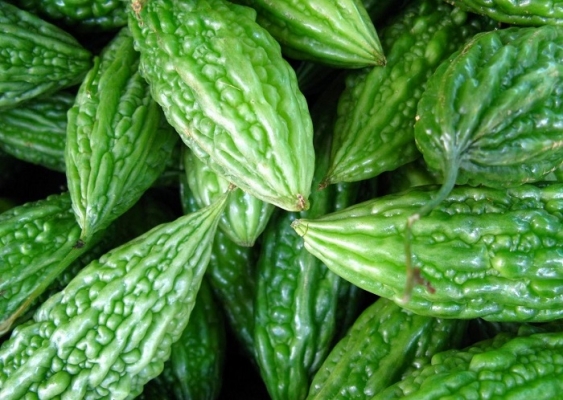Pusa Do Mousami: Suitable for summer as well as kharif season. Fruits are medium, long and green. Ready for first picking in 55days after sowing.
Pusa Vishesh: Fruits are green, thin and medium size. Gives average yield of 48-52qtl/acre.
Arka Harit: Fruits are shiny green. Ready to harvest in 120days after sowing. Fruits with less seed and with less bitterness. Gives average yield of 52qtl/acre.
Kashi Harit: Fruits are dark green. Ready for first harvest in 50days after sowing. Gives average yield of 120qtl/acre.
Kashi Urvashi: Fruits are straight and green color. Ready for first picking in 60days after sowing. Gives average yield of 120qtl/acre.
Priya: Fruits are near about 40cm long. Ready for first picking in 60days after sowing.
Kalyanpur Baramansi: Fruits are long i.e 30-50cm with light green color. Suitable for rainy season cultivation.
Faijabadi: Local variety. Fruits are long, medium size and dark green color.
Pant Karela 1: Fruits are thick. Ready to harvest in 55days. Gives average yield of 60qtl/acre.
Pusa Hybrid 2: Minimum long, thick and glossy green fruits.
Other state varieties:
CO 1: The variety has medium sized fruit which are long and dark green in color. The fruits have an average weight of 100-120gm. It gives an average yield of 5.8t/acre and the variety matures in 115 days.
COBgoH 1: The variety matures in 115-120 days and gives an average yield of 20-21t/acre.
MDU 1: The fruit are 30-40cm in length and matures in 120-130 days. It gives an average yield of 13-14t/acre.
Punjab Kareli-1: Released in 2009. The variety has green leaves which are smooth and serrated. They bear long fruits which are thin and green in color. First fruit harvesting is done after 66 days. The fruits have an average weight of 50gm and it gives an average yield of 50qtl/acre of fruit.
Punjab-14: Released in 1985. The plant has small vines. The fruits have an average weight of 35gm and are light green in color. The variety is suitable for sowing during rainy or spring season. It gives an average yield of 50qtl/acre.






